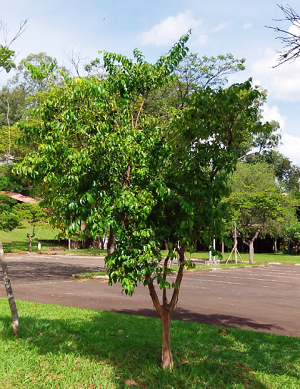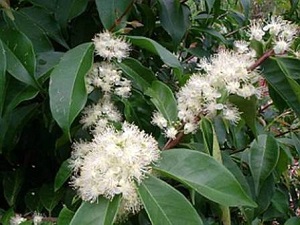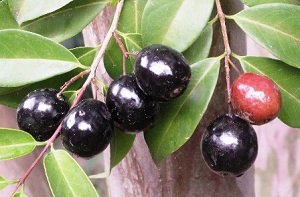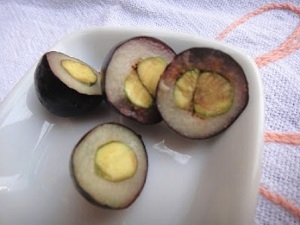Publication from Fruitipedia, Encyclopedia of the Edible Fruits of the World
by Dr. Chiranjit Parmar
Rainforest Plum
Eugenia candolleana
Myrtaceae

A tree of rainforest plum
Other names: Cambui roxo (purple cambui) , murtinha (little myrtle)
Rain
forest plum is relatively a less common fruits compared to other
species of Eugenia. It is believed to be a native of coastal Atlantic
forests of Brazil. It bears small dark purple fruits with a mildly
sweet and firm pulp. It fruits several times a in a year and is a heavy bearer too.
Description
A
shrubby tree growing to 10-12ft. Flowers are born in large clusters,
with fruits ripening several weeks later. There are both purple and red
fruited forms. A medium sized tree 3–6 m tall and with a
rounded or conical canopy up to 2 m wide, bark reddish brown peeling
off naturally exposing reddish trunk. Leaves rusty-brown in the
beginning turning yellow and then deep dark green later, in opposite
pairs, with smooth leathery texture, smooth edges, and the apex curved
downwards.

Rainforest plum flowers
Flowers borne in groups of 20 or more stalks, each bearing two flowers, sprouting from the base of leaf stalks.
Fruits
round or slightly elongated berry, up to 20 wide and 25 mm long; with
thin purple-black skin, pulp wet, firm, whitish, 3–5 mm thick, is
edible, moderately sweet, with an aroma similar to (but less intense
than) that of the jaboticaba.

Rainforest plum fruits
Utilization
Fruits
are edible and eaten fresh and are very much liked by all. These are
also made into jams. The unpitted fruits are great for making cake and
also serve to make juices, ice creams and jellies. The flowers are bee
pollinated and the tree is ornamental and can be grown successfully in urban areas.
The
infusion of leaves has been used for the treatment of pain and fever.
The essential oil distilled from the leaves (green 0.14% by weight)
contains isomers of guaiol and cadinol, δ-elemene and
viridiflorene.

Cut fruits of rainforest plum
Cultivation
Rain
forest plum thrives best in full sunlight and requires good irrigation
during the flowering and fruiting seasons. It can be propagated from
seeds. The seeds, however, loose viability soon and therefore should be
planted within 20 days of extraction. The tree is easy to grow and
starts bearing fruits after two years.
Other Edible Eugenia species:
Cherry of the Rio Grande, E. involucrata
Grumichama, E. brasiliensis
Pitomba, E. luschnathiana
Surinam Cherry, E. uniflora
Back to
Fruit Tree Index Page
|
|



